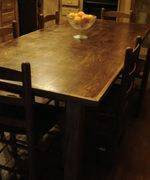
It really is our money.
Big numbers like a 14 trillion dollar national debt, ( David Walker, Comptroller of the Currency under Bush, suggests the implied debt is really 65 trillion) are disregarded because none of us can conceive of them. Nonetheless these figures will be a factor in all our lives as we have to pay this obligation off, or suffer the ravages of bankruptcy if we don't. This debt was created by government spending more than they took in revenues. The way this debt is retired is our payment of taxes. The government could sell off land holdings, oil leases, federal buildings, but the bulk of the debt will be paid through our taxes. Our collective obligation to pay.
This is the funny season when tax attorneys and estate planners sharpen their pencils and begin to design the ways and means that their clients can avoid taxes. As the time gets nearer and the rhetoric on tax and debt issues gets louder, you are going to hear some tired arguments. The most common is that the poor, or 47% of citizens will pay no taxes, and that the rich pay the disproportionate share of all taxes. The latter is true as far as it goes. The issue here is are they paying what they MIGHT owe, and if not who is responsible for their share?
By example. Lets say ten of us agree to buy a $10,000 plot of land on which to grow veggies. We borrow the money. To keep it simple we have an interest only loan at 5% principle due in 20 years. We owe $500 interest a year per share. If for any reason, one of us doesn't or can't make their payment, the loan isn't reduced, it is redistributed among the remaining payers. We each have to kick in 10% more. We might penalize the non payer and deny him his share of the veggies. When it comes to government goods and services there is no take back of services from those who don't pay.
So taxes that are not collected from one of us, are made up for by the rest of us.
This is the time of the year when Forbes publishes its list of the richest persons in America. It is also a convenient time for many of those on the list to trot out their charitable activities. These charities are created by diverting money that would otherwise be paid in taxes into a variety of instruments, lets summarize and call them foundations.
The Wealth Management Exchange is just one of thousands of organizations that can help you create a foundation.
Here is a quick summary of benefits:
Private Foundations At A Glance
• Immediate income tax deductions for amounts donated to foundation
• Reduce income taxes by up to 30% per year
• Exempt from Estate and gift tax
• Long-term build up of foundation assets free of income tax
• Complete legal control of foundation during life of founder
• The ability to make the world a better place through a sustained long-term program of well planned and executed charitable giving
• A unique opportunity to share value and vision with children and grandchildren
• Build a permanent legacy
• After founder passes, foundation may stay under family control
The last entry means that heirs, who did nothing but get lucky choosing a parent, carry on the family business, and they too pay no taxes.
When Ted Turner announced his enormous gift to the U.N. he was also generous about how the system works for him. A USA Today story characterized the gift as follows:
Turner’s gift, it turns out, is not as generous as described in media reports. An amount of up to $1 billion will be donated in the form of Time-Warner stock in ten annual installments. The cost to Turner could be significantly less than $1 billion if he takes advantage of tax write-offs, tax deductions and ways to avoid estate taxes. Amazingly, USA Today claims "Turner, or at least his heirs, could end up $100 million richer because he’s giving a billion away."
So just to hammer home the point, the tax advantages that accrue to the rich, will be made up for by the rest of us, with our money, and the charities they create are funded with our money. When you read of the good work that is being done be sure to stand up and declare it is in your name, with your money.

 The man had style. In an attempt to look as good we are going to need expert guidance. It exists. Every man has a dad in the name of the "style guru". Here is a basic guide to choosing a suit.
The man had style. In an attempt to look as good we are going to need expert guidance. It exists. Every man has a dad in the name of the "style guru". Here is a basic guide to choosing a suit. 





